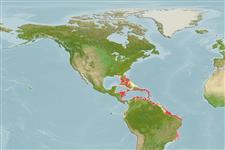Environment: milieu / climate zone / rango de profundidad / distribution range
Ecología
marino asociado a arrecife; no migratorio; rango de profundidad 2 - 30 m (Ref. 9710). Tropical; 32°N - 27°S, 86°W - 32°W (Ref. 5222)
Western Atlantic: Bermuda, south Florida (USA), Gulf of Mexico, the Bahamas, Cuba, West Indies, Panama, Venezuela, and southward to the state of São Paulo, Brazil. Alphestes afer has recently been re-discovered at São Tomé in the Gulf of Guinea of the Eastern Atlantic.
Length at first maturity / Tamaño / Peso / Age
Madurez: Lm 18.0, range 18 - 18.4 cm
Max length : 33.0 cm TL macho / no sexado; (Ref. 5222)
Espinas dorsales (total) : 11; Radios blandos dorsales (total) : 17 - 20; Espinas anales: 3; Radios blandos anales: 9 - 10. Diagnosis: Body depth is slightly less than head length, depth contained 2.4-3.1 (2.9) in standard length; caudal peduncle depth 7.0-9.0 (8.5) times in SL; eye diameter greater than or equal to snout length and 8.1-15.0 (13) times in SL; snout length 10.1-16.0 (16.0) times in SL; preopercle rounded, posterior edge serrate, with a large antrorse spine at the angle directed downward and forward and usually covered with skin. Gill rakers 5-8 (7) on upper limb, 14-17 (16) on lower limb, 19-25 (23) total, including rudiments. Dorsal fin with XI spines and 17 to 20 (18) soft rays, anal fin with III spines and 9, rarely 10 (10) soft rays; pectoral fins with 16 - 18 (17) rays; caudal fin rounded, with 15 branched rays. Scales are smooth. Lateral-line scales 49-66; lateral scale series 68 – 88 (76). Color in life; head, body, and median fins olivaceous or light brown, irregularly blotched and barred with dark brown. Some individuals are densely spotted with orange; head, body, and all fins often with scattered white spots; body sometimes covered with scattered small black dots; pectoral fins may be orange or yellow with faint dark reticulations (Ref. 57865); Color in market: almost similar to color in life but general body color may fade to a pale drab cream, also spots and reticulations may fade (Ref. 89707).
Body shape (shape guide): fusiform / normal; Cross section: oval.
A solitary species (Ref. 26340) occurring in seagrass habitats. Sedentary during the day, hiding in crevices or lying among seaweed, sometimes partly covering itself with sand while lying on its side. Nocturnal feeders of benthic crustaceans. Estimated eggs per fish is from 157512 to 223706 (Ref. 29). Small, colorful group; a sequential hermaphrodite (Ref. 26938). Has been traded as an aquarium fish at Ceará, Brazil (Ref. 49392).
Protogyny is unconfirmed for this species (Ref. 103751).
Heemstra, P.C. and J.E. Randall, 1993. FAO Species Catalogue. Vol. 16. Groupers of the world (family Serranidae, subfamily Epinephelinae). An annotated and illustrated catalogue of the grouper, rockcod, hind, coral grouper and lyretail species known to date. Rome: FAO. FAO Fish. Synop. 125(16):382 p. (Ref. 5222)
IUCN Red List Status (Ref. 130435: Version 2025-1)
Threat to humans
Reports of ciguatera poisoning (Ref. 30303)
Human uses
Pesquerías: escaso valor comercial; Acuario: Comercial
Herramientas
Special reports
Download XML
Fuentes de Internet
Estimates based on models
Preferred temperature (Referencia
123201): 25.6 - 28.1, mean 27.5 °C (based on 668 cells).
Phylogenetic diversity index (Referencia
82804): PD
50 = 0.6250 [Uniqueness, from 0.5 = low to 2.0 = high].
Bayesian length-weight: a=0.00447 (0.00259 - 0.00771), b=2.87 (2.73 - 3.01), in cm total length, based on LWR estimates for this species & (Sub)family-body (Ref.
93245).
Nivel trófico (Referencia
69278): 3.6 ±0.5 se; based on diet studies.
Resiliencia (Referencia
120179): Alto, población duplicada en un tiempo mínimo inferior a 15 meses (Fec=150,000-220,000).
Fishing Vulnerability (Ref.
59153): Low vulnerability (23 of 100).
🛈
Nutrients (Ref.
124155): Calcium = 47.5 [29.1, 84.8] mg/100g; Iron = 0.557 [0.308, 0.928] mg/100g; Protein = 18.5 [16.7, 20.1] %; Omega3 = 0.143 [0.097, 0.216] g/100g; Selenium = 27.2 [17.3, 47.4] μg/100g; VitaminA = 106 [38, 322] μg/100g; Zinc = 1.22 [0.86, 1.71] mg/100g (wet weight);
